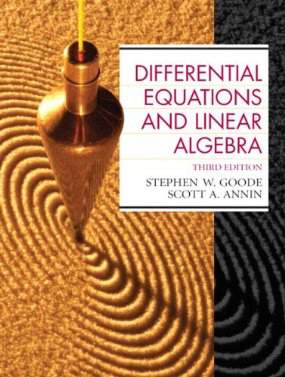
This is a quick preview of the lesson. For full access, please Log In or Sign up.
For more information, please see full course syllabus of Differential Equations
For more information, please see full course syllabus of Differential Equations
Differential Equations Linear Equations
Lecture Description
In this lesson, our instructor Will Murray gives an introduction on linear equations. He explains how to solve linear equations and the importance of the constant when integrating both sides of the equation.
Bookmark & Share
Embed
Share this knowledge with your friends!
Copy & Paste this embed code into your website’s HTML
Please ensure that your website editor is in text mode when you paste the code.(In Wordpress, the mode button is on the top right corner.)
×
- - Allow users to view the embedded video in full-size.
Next Lecture
Previous Lecture










































 Answer Engine
Answer Engine







1 answer
Mon May 8, 2017 9:42 AM
Post by Emanuel Fonseca on May 6, 2017
Im doing turning machines and I could not find anything on this website to help me could you please help me with this problem
Unless otherwise stated, M and N are TM’s, G and H are CFG’s; The alphabet ? is {0.1}. Decide whether each of the following sets is (A) computable, (B) c.e. but not computable or (C) not c.e.
I think its C not C.E
{?G?: L(G) is infinite.}
1 answer
Mon Jan 9, 2017 10:11 AM
Post by Jim Tang on January 5, 2017
hey will! i was wondering if you can compare the rel difficulties of multivar calc and diff eq as i just finished my multivar calc class last semester. excited to learn diff eq this semester!
2 answers
Mon Jul 13, 2015 11:20 AM
Post by Kamal Gaal on July 11, 2015
Excellent lecture Dr. Murray. Just a slight overlook in the last example. The derivative of cosx = -sinx. Just quick question Dr. murray, if I cover all the material on math and physical on educator.com Is that going to be enough to do well on electrical engineering at university? Thanks for all that you do.
1 answer
Wed Jul 1, 2015 8:46 AM
Post by Guanzhong Du on June 23, 2015
Hello Professor Murray,
In my calc class, I learned that the antiderivative of 1/x is ln |x|, the natural log of an absolute value. In this lecture, however, you did not include the absolute value sign. For example, when you integrated 3/x, you wrote 3 ln (x) instead of 3 ln |x |. Why is it valid to drop the absolute value sign when solving ODEs?
Thanks! I really enjoy watching your lectures!
1 answer
Fri Feb 27, 2015 1:05 PM
Post by David Löfqvist on February 26, 2015
Slide 1, note 1 "we think of y and y' as variables... (not x and y)" is this a typo or do you mean something else?
1 answer
Mon Dec 15, 2014 1:19 PM
Post by Denny Yang [ Mod ♕ ] on December 13, 2014
Definitely a 5 Star lecture. Everything was crystal clear, and I enjoyed the watching this video. I wish you taught at my campus! (UCSD)
2 answers
Fri Sep 5, 2014 12:58 PM
Post by Bob Lowe on September 4, 2014
At 61:30, shouldn't it be x^2sinx + 2xcosx -2sinx?
3 answers
Mon Aug 25, 2014 6:36 PM
Post by Timothy Davis on August 20, 2014
Hello Dr. Murray,
When you rewrote the equation at about 1:16 into the video, you rewrote it without the x. (y' + Py = Q). Why did you leave the x out?
Original equation: y'(x) + P(x)y(x) = Q(x). I think I'm confused about the whole concept of linearity. I really didn't quite get your explanation for it. Could you explain further?
1 answer
Thu Mar 27, 2014 5:04 PM
Post by Gregory Gutierrez on March 22, 2014
You are an amazing teacher! Can you please teach your own version of Multivariable Calculus on here?
1 answer
Tue Mar 4, 2014 4:56 PM
Post by Timothy Davis on March 1, 2014
This question isn't pertaining to this video. However, I need to learn Exact and Bernoullis ( I think I spelled it right!) differential equations. I don't see them on the syllabus, unless I overlooked it. Do you cover these two topics?
1 answer
Tue Jan 7, 2014 12:15 PM
Post by Derek Nickerson on January 3, 2014
This is excellent. I've never had this topic explained so clearly! Thank you!
1 answer
Tue Dec 17, 2013 5:55 PM
Post by Edward Arreguin on December 11, 2013
In your calculus BC lecture on integration by parts you said that tabular integration doesn't work with trig functions. Why did it work here on the last example?
1 answer
Fri Sep 27, 2013 5:27 PM
Post by michael morris on September 26, 2013
Do you give a lecture on exact equations? I cant seem to find it on your table of contents.
1 answer
Fri Sep 27, 2013 5:18 PM
Post by Eddy Noboa on September 24, 2013
Hello Dr. Murray. Sorry for the confusion I made from the last comment. What I meant to say was at 16:06 you pull out the number 2 to behind the Integral. So, from x^2 inside the Integral on the next line you placed the 2 behind the integral and then the x goes away and instead you placed after the integral u e^u, why. And wha happened to the x and where does the u comes from.
3 answers
Wed Jan 11, 2017 10:23 AM
Post by Eddy Noboa on September 21, 2013
hello Dr. Murray. At 12:04 you said that is going to pull out the x^2 as 2 times u, or 2 integral u. Can you explain why.
3 answers
Fri Sep 27, 2013 5:11 PM
Post by Eddy Noboa on September 21, 2013
hello Dr. Murray, to better put my question. When multiplying I(x) into the equation, on y'(x), it was written; e^x^2/2 times y'. My question is where is the x on the y'(x). Since I(x) supposed to be included in the equation because it is written; y'(I(x))+ x(I(x)y=x^3 I(x). I think is should be like this; y'I(x)x + x(I(x))y=x^3(I(x)
1 answer
Sun Sep 22, 2013 8:51 AM
Post by Eddy Noboa on September 21, 2013
Hello Dr.Murray. Great video. I have a question; at 12:05, when multiplying I(x)to both side of the equation. You first started Multiplying the y'x where you replace x with e^x^2/2 times y' which I think is because the x is replaced by e^x^2/2. Now after the plus sign, we have xy=. My question, if you replaced on the y'x the e^x^2/2 with the x. I think It should be this way: e^x^2/2 times y only but you have it as; x e^x^2/2 times y, I feel that there is an extra x because if you replaced that one x before the + sign. After the plus sign, you are replacing the x by e^x^2/2 but yet there is another x, I am confused please explain if you can. Thanks
1 answer
Fri Sep 6, 2013 12:47 PM
Post by Timothy Davis on September 5, 2013
Hi Dr. Murray! As usual, your videos are great! However, when you were multiplying e^x^2/x by y'x you only included y'. Why is that? This was around 12:17 into the video on first order linear equations.
1 answer
Thu Jul 18, 2013 8:38 AM
Post by KyungYeop Kim on July 13, 2013
Hi Dr. Murray, your lecture is great and clear, but I have a question. Is it a legit introductory course to calculus for a beginner? I took pre-calculus last year and this is the first time getting into calculus. I wonder if I could start learning calculus with this lecture set. (What would you, considering I'm a total novice, recommend that I start with? a book or anything would be appreciated) Thank you.
1 answer
Mon Apr 8, 2013 7:57 PM
Post by William Dawson on April 7, 2013
Excellent! Wunderbar!